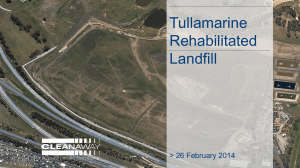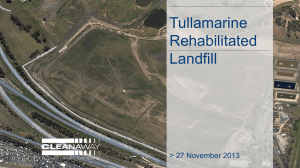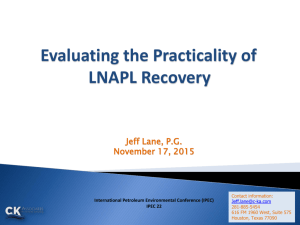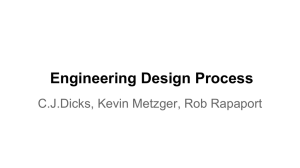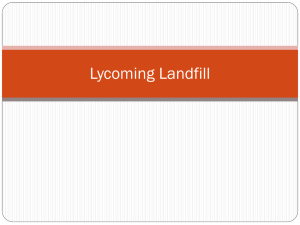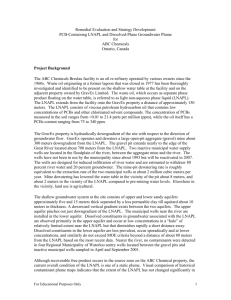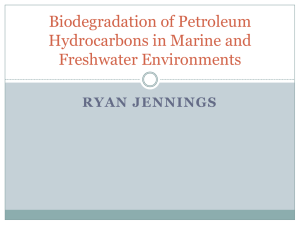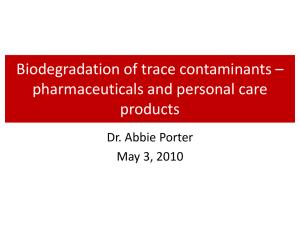TPI presentation
advertisement
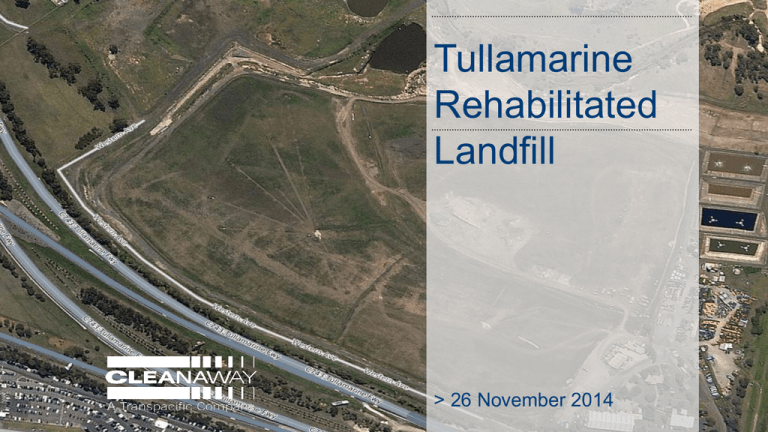
Tullamarine Rehabilitated Landfill > 26 November 2014 Post Closure Management Plan Progress Cap 2010 Mounds 1 & 2 Cap Construction 2011 2012 2013 Drainage connection approved by Melb Water & SEWPaC Works 2014 Tender & Works Commence 2014/15. Green Arrows = Water Act Vic, 1989 Deliverables Groundwater & Surfacewater Management (Risk Assessments Completed in 2004 & 2007 and Indicated Low Risks. A technical review was completed in 2011/12 of over 100 boreholes and along creek continues to confirm the same). Next Review 2014/15 Oil Groundwater Management Protocol (Approved by SRW) Liquid Product (LNAPL) Extraction (Feasibility trial commenced 2014) Gas Water Cap Audit Completed Landfill Gas Management (Landfill Gas Sampling and Perimeter Monitoring completed 2013 & final flare design & install 2014) Grey Arrows = Environmental Protection Act Vic, 1970, Deliverables Deliverables (Anticipated Dates) > > > > > LNAPL Trial Practicability Assessment (March 2015) Groundwater technical review (March 2015) Groundwater management plan update (March 2015) Landfill Gas Audit (September 2015) Stormwater Connection (Construction to Commence Summer 2014/15) > Landfill maintenance (mainly mowing - ongoing) > Ongoing monitoring (landfill gas, groundwater) LNAPL Trial Remaining Tasks > Consultation (workshop & questions tonight) > Questions are able to be put to EHS (and the IRP) until end of December (note now end of February 2015 as discussed in meeting) > Draft report issued to community mid to late January > Special meeting with EHS & A. Lane mid February > Practicability Assessment Report (Issued March 2015) > The Practicability Assessment Report will include consultation process and responses to questions from community. Reminder - What does the EHS report mean? > The trial has shown LNAPL extraction is not feasible because the volumes and recovery rates are so low > At current levels of recovery extraction will take in the order of 1,000 years > The LNAPL is effectively immobile > Other technologies were ruled out during planning / design because of risks to cap integrity and/or risk of mobilising contamination Reminder - What was proposed? > The EHS information is indicating further field trials are not justified > However it is only fair that the community and stakeholders have time to consider the detail in the technical information Why is it so difficult to extract? > Biodegradation is occurring in the landfill > Microbial bugs consume the easier less viscous (thinner more mobile) compounds first leaving thicker and less mobile compounds until last > Biodegradation is happening because : > The landfill temperature is declining > The landfill gas production is also occurring (and declining) What will happen to the LNAPL? > It won’t move > It will eventually turn into an inert material that looks something like black carbon > It will undergo anaerobic biodegradation and this will be explored in the EHS Practicability Assessment report (the process is called anaerobic reductive degradation and includes dechlorination, ie, chlorine in PCB is removed) > Transpacific will continue to monitor Next Steps > Opportunity to ask questions and seek clarification. > Reports were made available on the community web site. > Consultation continues beyond the original 6 to 8 weeks envisaged from the 15th Sept (when the community can ask questions / comment on the reports). > Opportunity to ask questions at tonight’s meeting. Next Steps ctd… > Transpacific to make EHS and the Independent Review Panel available for questioning (tonight). > Transpacific will use tonight’s meeting to assist the community formulate questions to our experts. > We will take further questions until end of December (now end of February) and EHS can respond in detail in the Practicability Assessment report (March 2015). > Site visit to the Landfill (two members attended) Reminder of The Technology Screen • Hydraulic Containment • Impermeable Barrier • Excavation and Disposal • In-Situ Vitrification • In-Situ Cement Solidification •Fluids Extraction • Active Skimming • Belt Skimming •Steam Injection •Resistive Heating •Solvent Extraction •Surfactant Flushing •Air Drive / Water Flood •Vacuum Extraction •Vacuum Enhanced Hydraulic Recovery • In-Situ Chemical Oxidation (ISCO) •Bioremediation Technology Considerations Health, safety and environmental impacts/ risks, including: • Generation of vapour / dust emissions • Penetrations through and/ or damage to the land fill cap • Permanent changes in LNAPL characteristics • LNAPL mobilisation • Landfill fires • LNAPL storage and handling Multiple Technologies Employed at Tullamarine Landfill > Cap (Installed) > Hydraulic Control (Assessments will be completed March 2015 – SRA, HA and LNAPL Trial) > Gas Collection and Emissions Flaring (Installed and currently undergoing confirmatory assessment). > GW & LFG Monitoring (Monitoring network installed and monitoring is ongoing) > Natural Attenuation [attenuation assessment completed for the Technical Review (TRAR), currently being reviewed by Auditor]. Technology Considerations > The Natural Attenuation assessment indicates dissolution from LNAPL (until it naturally depletes) will be managed effectively via Monitored Natural Attenuation. More to report on this at the next meeting. > The landfill gas collection system vacuum can be considered as an active management measure for collecting vapour emissions and assisting with stripping volatile components of the LNAPL which are typically the most soluble as well. Mobility Over Time Data from US 0.4 0.3 Tn (m2/d) After R. Charbeneau, 2012 0.2 0.1 0 0 2 4 6 Time (Years) 8 10 Recovery Rate Over Time Data from US First liquid disposal about 1973 & last disposal in 1987 (about 40 years since first disposal & 27 years since last disposal. 0.4 Extraction Only Bio degradation Only Extraction + Bio degradation 0.3 ML 0.2 0.1 After T. Sale, 2012 0 0 10 20 Time (Years) 30 40 Tullamarine Landfill > The landfill is in the period between ability to practically extract and LNAPL being absorbed to clay particles > Note that intervention has potential to cause greater harm Biodegradation Processes Biodegradation Processes - Landfill Biodegradation Processes - Landfill Cap Gas Collection Layer Flare Waste LNAPL Biological Activity Biological Activity Leachate PCB CONCENTRATION Max Concentration (mg/kg) Median Concentration (mg/kg) 250 Concentration halves in anaerobic soil every 9 years, Beurskens et al. (1993) 200 150 100 Location PCB Concentration (mg/kg) L11 5 L4 21 L5 29 Well 6 31 L7 38 L13 60 L14 102 L3 102 L8 106 L12 123 L1 188 L2 210 Well 15 212 L9 215 50 mg/kg NEPM Soil Guideline for Industrials Sites 50 0 0 20 40 60 80 100 120 Monitored Natural Attenuation Natural Attenuation and Biodegradation > Biodegradation via anaerobic reductive dechlorination and volatilisation enhanced with the landfill gas collection system. These two process are likely the key ones for the ultimate degradation of the LNAPL at the site. > LNAPL at Tullamarine is more complex than “standard petroleum site”. Biodegradation is also considered important for a wide range of contaminated sites and as such has much wider applicability than just standard petroleum sites. Biodegradation (US EPA Fact Sheet) Biodegradation (US EPA Fact Sheet) > “Fortunately, petroleum hydrocarbons appear to degrade to less harmful products in almost all cases.” USEPA Remedial Technology Options Fact Sheet ‘Monitored Natural Attenuation of Petroleum Hydrocarbons’ Disclaimer This document has been prepared by Transpacific Industries Pty Ltd (ABN 40 010 745 383) (“Transpacific”) for the purposes of providing the recipient with an update on the status of rehabilitation works at Tullamarine landfill site. This document has been prepared on the condition that it is for the exclusive information and use of the recipient. This document may not be reproduced, distributed or published by any person for any purpose. No part of this document may be quoted or referred to in any other document. With the exception of information provided by external sources, Transpacific retains all applicable intellectual property rights which arise from the creation of this document. This document is subject to the limitations, assumptions and qualifications referred to in it. In addition to any other rights available to them, Transpacific or any related party (“Transpacific Parties”) herein expressly advise that they: 1. make no representation or warranty, express or implied, as to the accuracy, currency, reliability or completeness of any statements, estimates, opinions or other information contained in this document; and 2. to the maximum extent permitted at law, the Transpacific Parties are not responsible or liable in any way whatsoever for any claim, loss, damage, cost or expense, whether direct, indirect, consequential or otherwise, arising (whether in negligence or otherwise) out of use or reliance on this document, its contents or any omissions from it. Transpacific Parties means Transpacific, its related bodies corporate, directors, officers, employees, representatives, consultants and agents; and a Transpacific Party means any of them. Thank you for your time
